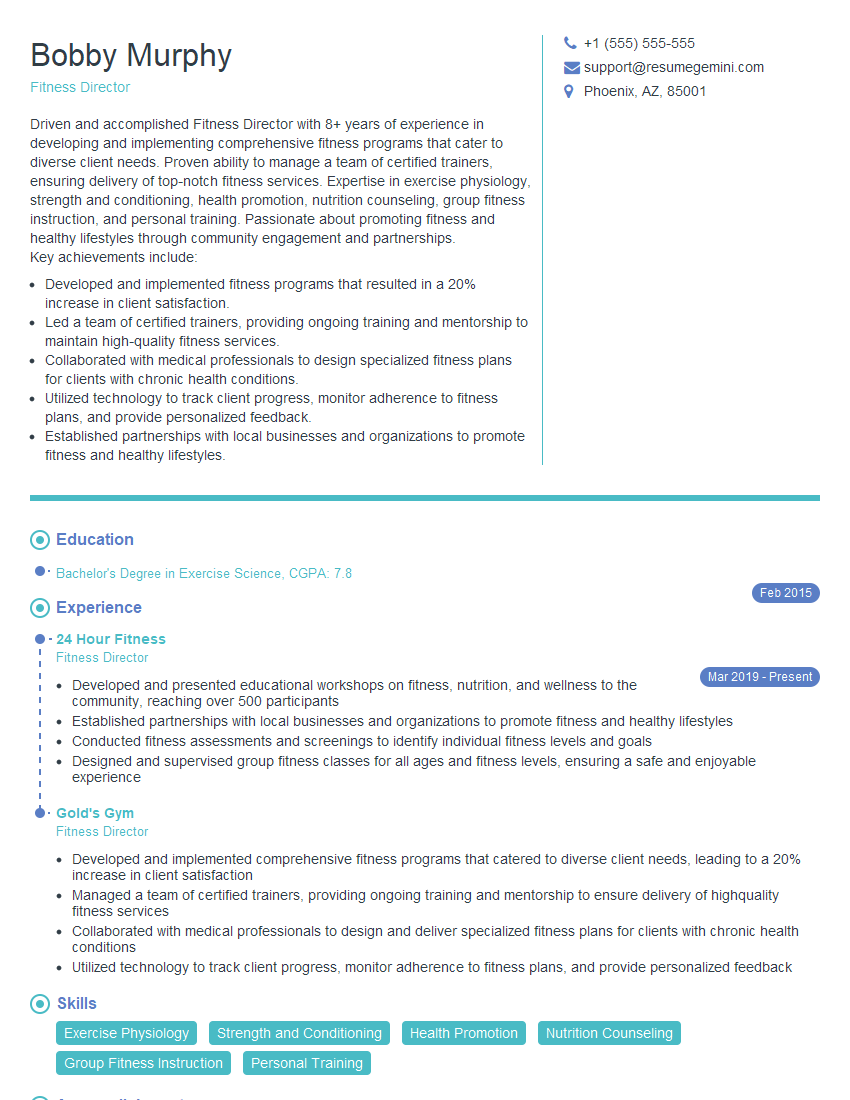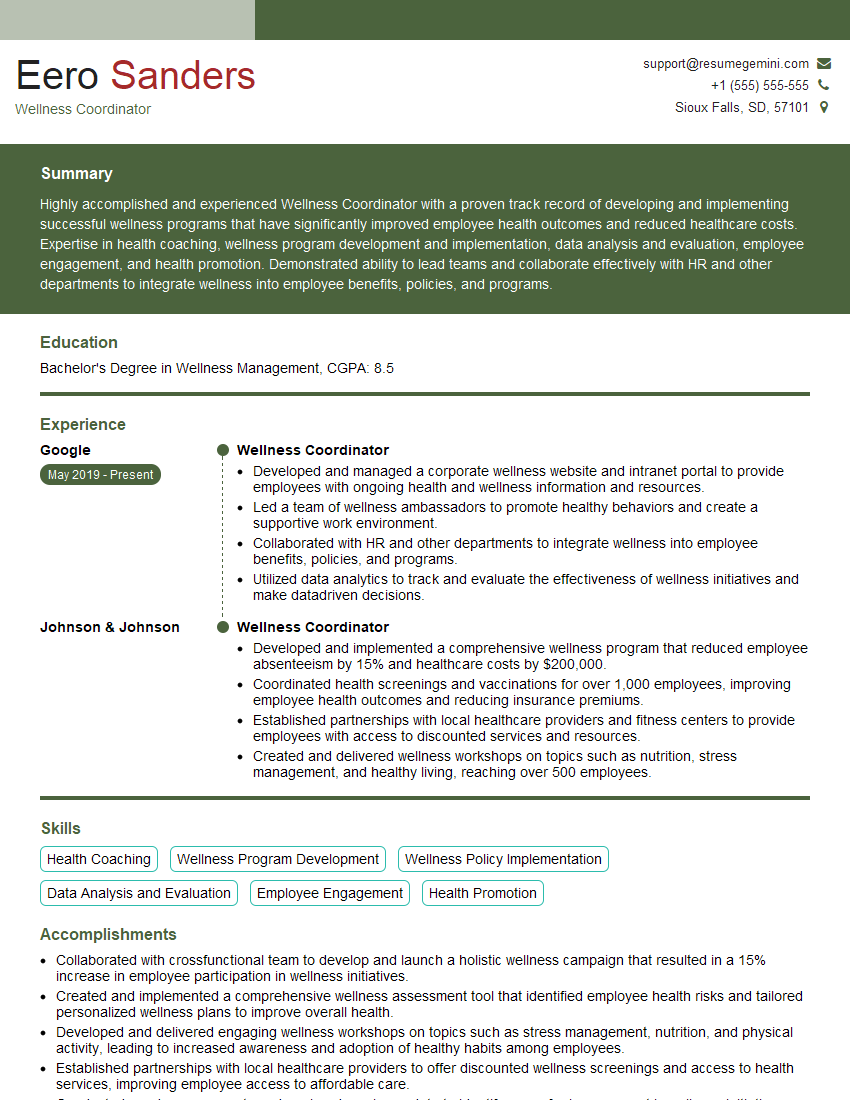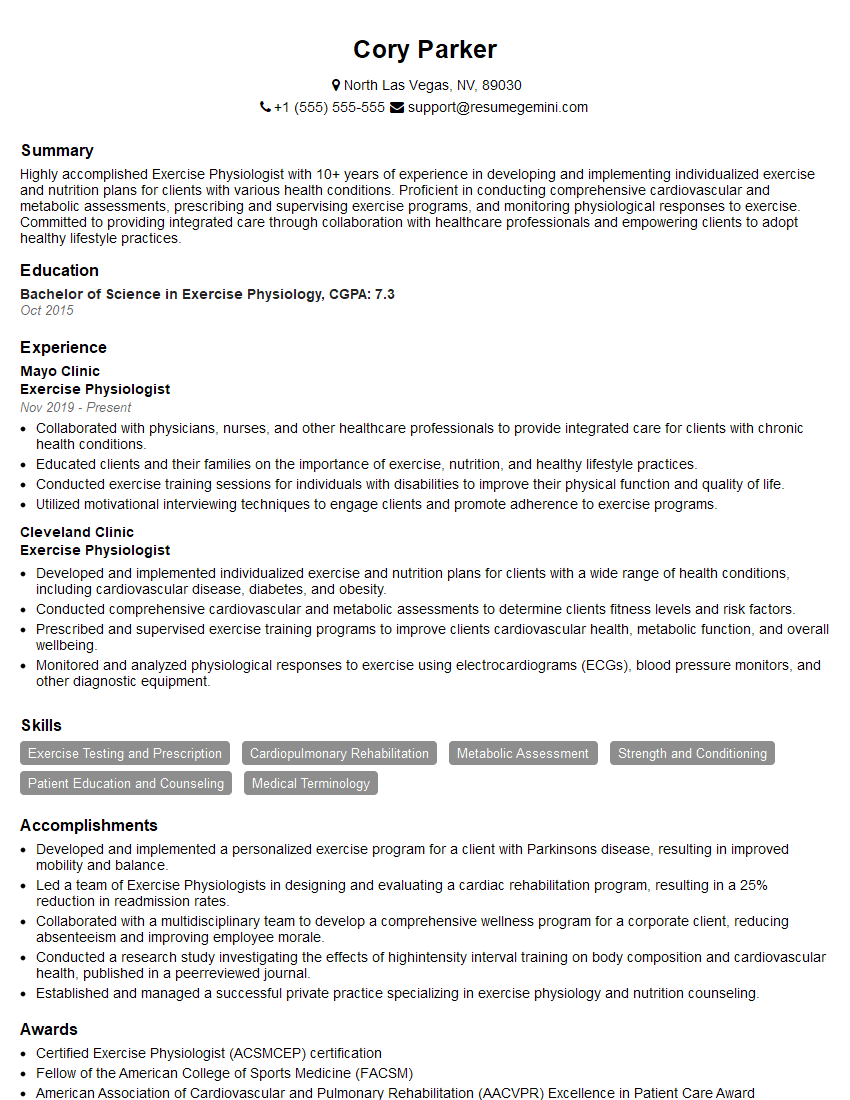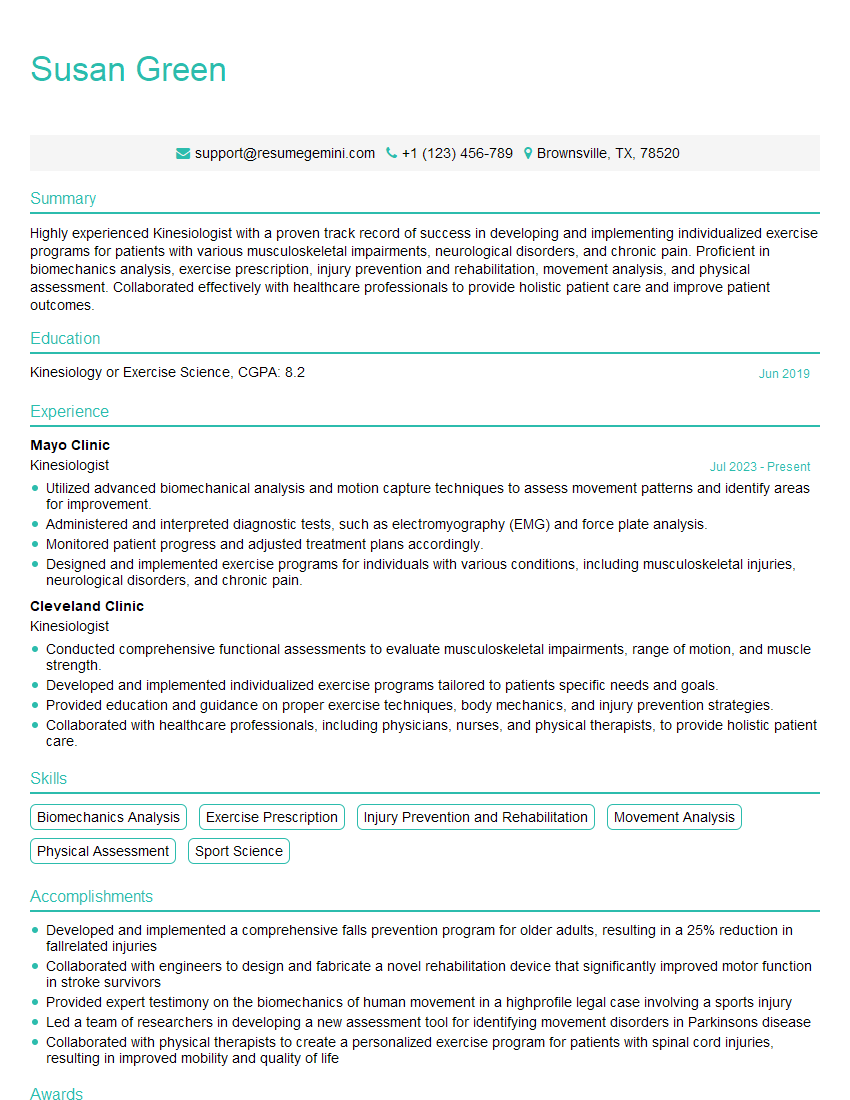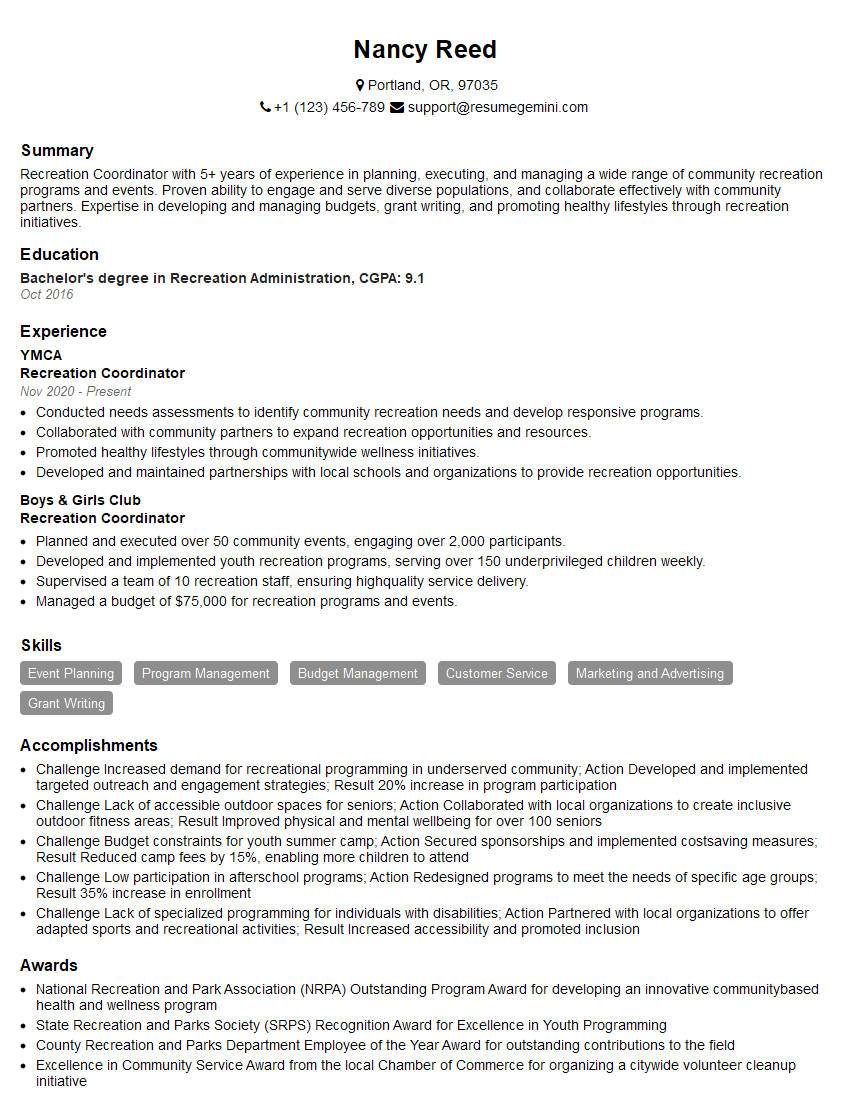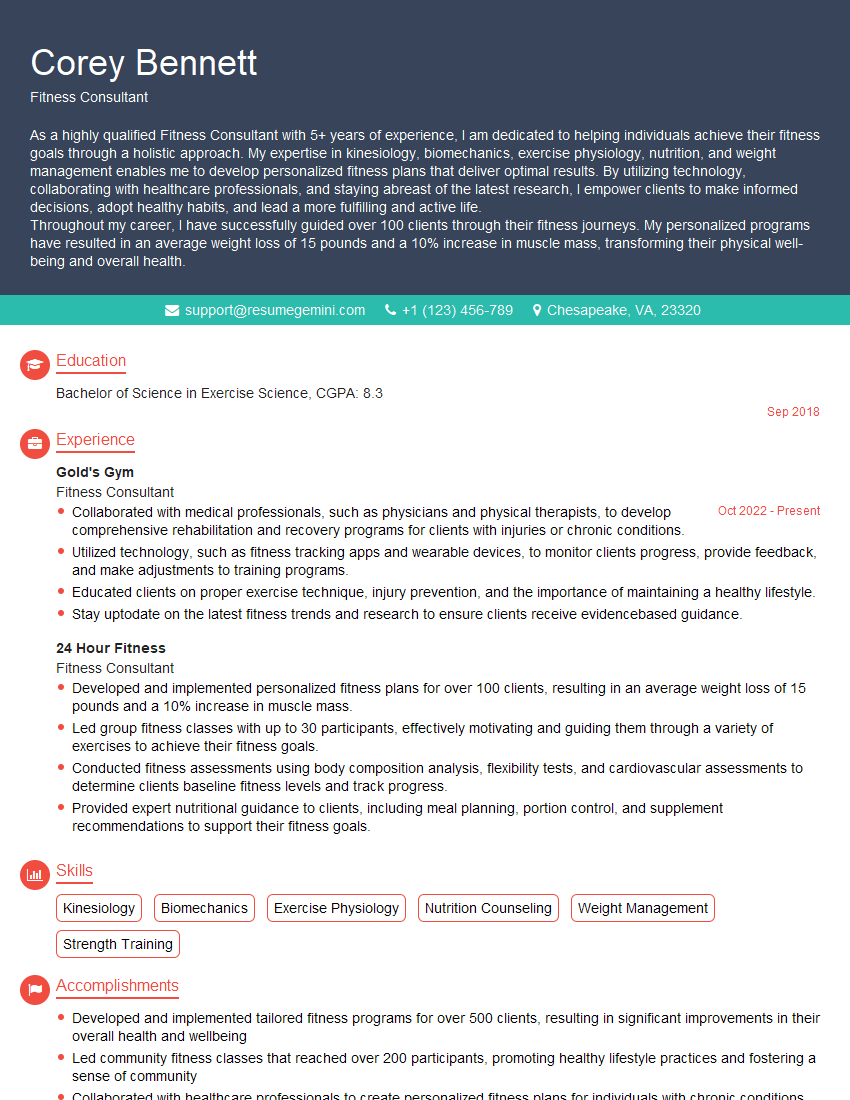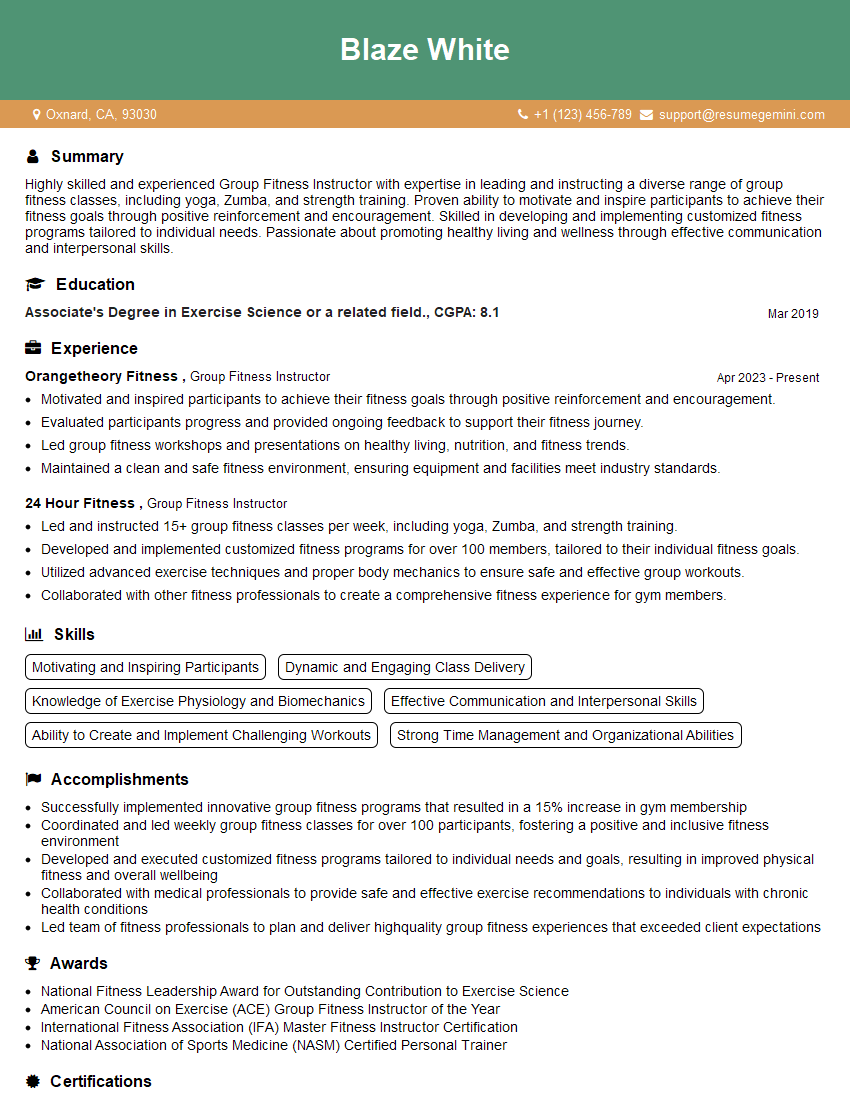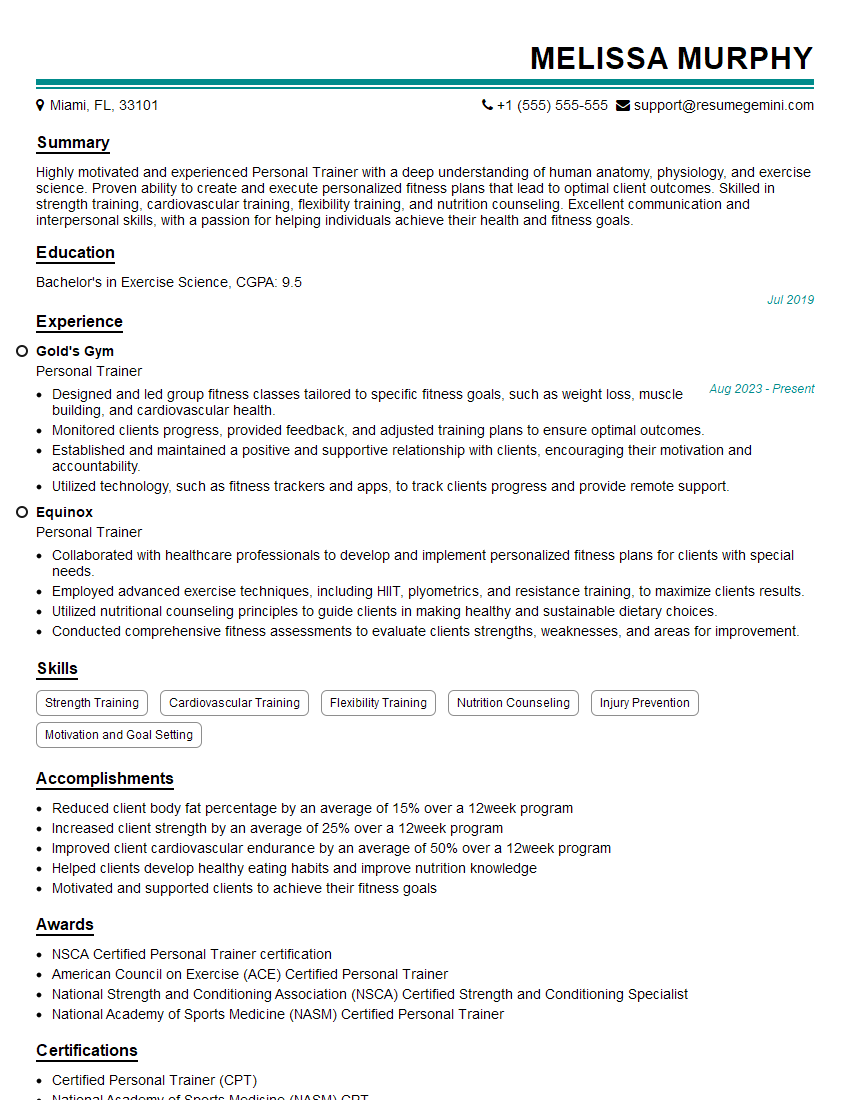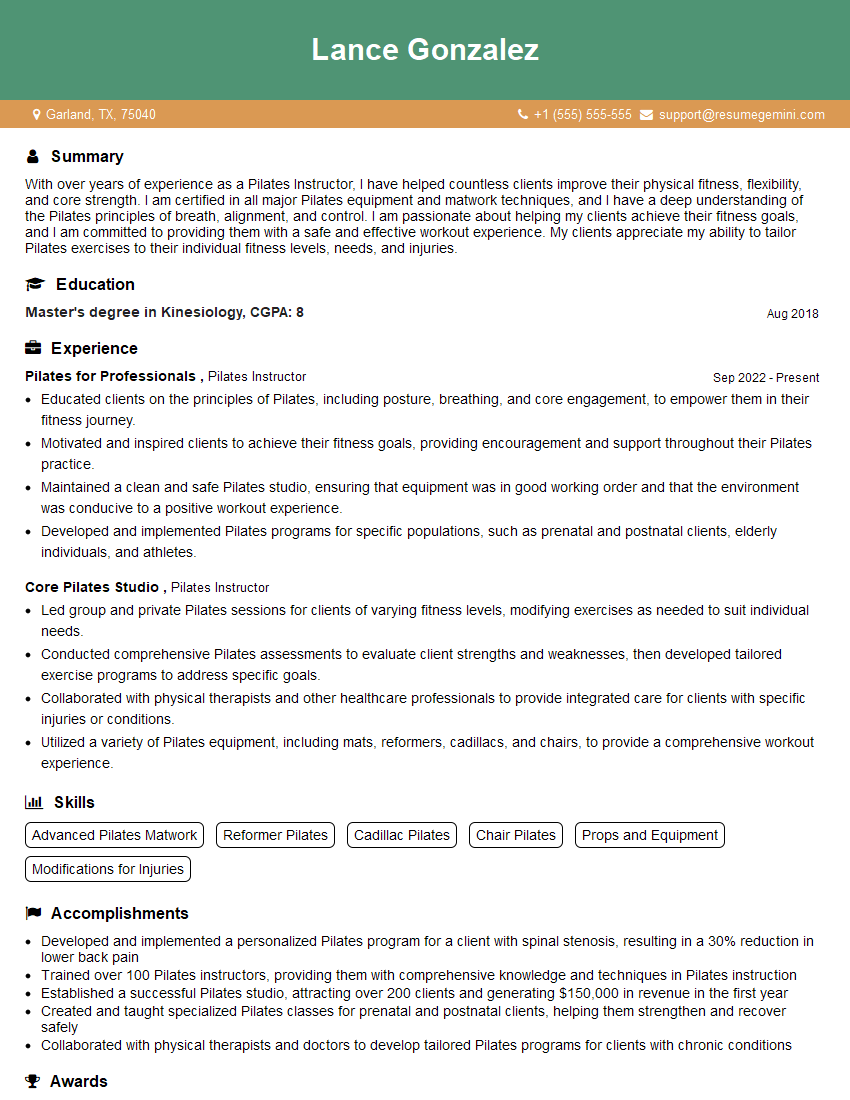The right preparation can turn an interview into an opportunity to showcase your expertise. This guide to Physical Fitness and Activity Level interview questions is your ultimate resource, providing key insights and tips to help you ace your responses and stand out as a top candidate.
Questions Asked in Physical Fitness and Activity Level Interview
Q 1. Explain the principles of overload and progression in exercise programming.
The principles of overload and progression are fundamental to effective exercise programming. They guide how we challenge the body to improve fitness. Overload refers to stressing the body systems beyond their accustomed levels. This is achieved by increasing the intensity, duration, or frequency of exercise. Think of it like this: if you always lift 5kg, you need to increase the weight to 6kg or more to see continued gains. Progression builds upon overload. It involves gradually increasing the training demands over time to prevent plateaus and continue improving fitness. This isn’t about constantly pushing yourself to the brink, but rather a carefully planned increase in challenge.
- Overload Example: Increasing the weight lifted, running further, or performing more repetitions in weight training.
- Progression Example: Starting with a 30-minute walk three times a week, then progressing to 45 minutes, then incorporating some jogging, and finally adding hills or interval training.
In essence, overload is the stimulus for change, while progression ensures that the stimulus remains challenging and continues to drive adaptations.
Q 2. Describe the difference between aerobic and anaerobic exercise.
Aerobic and anaerobic exercise differ primarily in how they utilize oxygen. Aerobic exercise, also known as cardiovascular exercise, uses oxygen to produce energy. It involves sustained activity at moderate intensity, allowing your body to efficiently deliver oxygen to working muscles. Examples include jogging, swimming, cycling, and brisk walking. These activities improve cardiovascular health, endurance, and burn calories effectively over time.
Anaerobic exercise, conversely, occurs when your body’s oxygen supply is insufficient to meet the energy demands. This type of exercise involves short bursts of high-intensity activity. Examples include sprinting, weightlifting, and plyometrics. Anaerobic exercise builds muscle strength and power, improves speed and agility, but generally provides less significant calorie expenditure in a single session compared to longer bouts of aerobic training.
Imagine a marathon runner (aerobic) versus a weightlifter (anaerobic). The runner needs stamina and endurance, relying on oxygen throughout the race. The weightlifter needs explosive power for short, intense lifts.
Q 3. What are the components of fitness?
The components of fitness are often categorized into several key areas, each contributing to overall health and well-being. These components are interconnected and work together. They include:
- Cardiorespiratory Endurance: The ability of the heart and lungs to deliver oxygen to working muscles. (e.g., running, swimming)
- Muscular Strength: The maximum force a muscle or muscle group can exert in a single effort. (e.g., weightlifting)
- Muscular Endurance: The ability of a muscle or muscle group to perform repeated contractions over time. (e.g., push-ups, sit-ups)
- Flexibility: The range of motion around a joint. (e.g., stretching)
- Body Composition: The proportion of fat mass to lean mass (muscle, bone, organs) in the body. (e.g., measured through body fat percentage)
- Balance: The ability to maintain equilibrium. (e.g., yoga, tai chi)
Improving each of these areas contributes to a holistic approach to fitness.
Q 4. How do you assess an individual’s fitness level?
Assessing an individual’s fitness level involves a combination of methods, tailored to their specific goals and health status. This is not a one-size-fits-all process. Methods include:
- Resting Heart Rate: A simple measure indicating cardiovascular health. A lower resting heart rate generally suggests better fitness.
- Cardiovascular Fitness Tests: Tests like the VO2 max test (measuring oxygen consumption) or a submaximal graded exercise test (e.g., treadmill test) evaluate cardiorespiratory endurance.
- Muscular Strength and Endurance Tests: These may involve one-repetition maximum (1RM) tests for strength, or assessing repetitions to failure for endurance in exercises like push-ups or sit-ups.
- Flexibility Tests: Using tools like a sit-and-reach test or goniometer to measure joint range of motion.
- Body Composition Assessments: Methods such as skinfold calipers, bioelectrical impedance analysis (BIA), or underwater weighing are used to estimate body fat percentage.
- Balance Tests: Evaluating static and dynamic balance through tests like the Romberg test or single-leg stance test.
- Health Questionnaires and Physical Exams: Essential for identifying any pre-existing conditions that may impact exercise selection and intensity.
The combination of tests selected depends on the individual’s goals and health status. A thorough assessment needs to include a consultation to understand their background and objectives.
Q 5. Explain the role of flexibility and balance in overall fitness.
Flexibility and balance are often overlooked but crucial components of overall fitness. Flexibility, the ability to move joints through their full range of motion, prevents injury, improves posture, and enhances athletic performance. Limited flexibility can lead to muscle imbalances, stiffness, and reduced performance. For example, tight hamstrings can increase the risk of lower back pain. Balance, the ability to maintain equilibrium, is essential for daily activities and reduces the risk of falls, particularly important as we age. Good balance is also critical for athletic performance, providing stability and control during movement.
Maintaining both flexibility and balance through regular stretching and balance exercises improves coordination, reduces injury risk, and contributes to a higher quality of life.
Q 6. What are the benefits of regular physical activity?
Regular physical activity offers a plethora of benefits that extend far beyond just physical health. These benefits include:
- Improved Cardiovascular Health: Reduced risk of heart disease, stroke, and high blood pressure.
- Weight Management: Increased calorie expenditure helps in maintaining a healthy weight.
- Stronger Muscles and Bones: Increased bone density, reduced risk of osteoporosis, and improved muscular strength and endurance.
- Better Mental Health: Reduced risk of depression and anxiety, improved mood, and stress reduction.
- Improved Sleep: Regular exercise can lead to better quality sleep.
- Increased Energy Levels: Despite the initial exertion, regular exercise leads to increased energy throughout the day.
- Reduced Risk of Chronic Diseases: Lower risk of type 2 diabetes, certain cancers, and other chronic illnesses.
- Improved Cognitive Function: Enhanced memory, attention, and overall cognitive performance.
The benefits are cumulative and contribute to a healthier, longer, and more fulfilling life.
Q 7. How would you design a workout program for a sedentary individual?
Designing a workout program for a sedentary individual requires a gradual and safe approach. The emphasis should be on building a foundation of fitness rather than pushing them too hard too soon. Here’s a sample program:
- Phase 1 (Weeks 1-4): Focus on building a base level of fitness.
- Daily: 30 minutes of brisk walking.
- 2-3 times per week: Light strength training focusing on major muscle groups (e.g., squats, push-ups against a wall, bicep curls with light weights or resistance bands). 1-2 sets of 10-12 repetitions per exercise.
- 2-3 times per week: Static stretching (holding each stretch for 30 seconds).
- Phase 2 (Weeks 5-8): Gradually increase intensity and duration.
- Daily: 45 minutes of brisk walking or jogging (gradually incorporating jogging intervals).
- 2-3 times per week: Strength training, increasing weight/resistance, sets, or reps as tolerated. Aim for 2-3 sets of 10-12 repetitions.
- 2-3 times per week: Static and dynamic stretching (incorporating dynamic stretches before workouts).
- Phase 3 (Weeks 9 onwards): Continue to progress and incorporate variety.
- Include other forms of cardiovascular exercise (e.g., swimming, cycling).
- Continue to increase the intensity and complexity of strength training, exploring more exercises and equipment.
- Regularly reassess and adjust the program based on progress and individual needs.
Important Considerations: Before starting any exercise program, consult a healthcare professional. Listen to your body, rest when needed, and focus on proper form. Progress should be gradual and sustainable, aiming for long-term adherence to an active lifestyle.
Q 8. How would you modify a workout program for an individual with a specific injury or condition?
Modifying a workout program for someone with an injury or condition requires a careful and individualized approach. The primary goal is to maintain fitness while avoiding further injury. First, I’d need a thorough understanding of the injury or condition, ideally from medical documentation or consultation with their physician or physical therapist. This includes the location, severity, and limitations imposed by the injury.
For example, if a client has a knee injury, exercises that put stress on the knee joint, such as deep squats or lunges, would be modified or avoided. We might substitute with low-impact alternatives like cycling, swimming, or elliptical training. If they have a shoulder injury, overhead presses would be replaced with exercises that don’t put stress on the injured area. We would likely incorporate exercises that strengthen the supporting musculature around the affected area.
The modifications might involve reducing the intensity, duration, or frequency of the workouts, focusing on range of motion exercises, or incorporating specific therapeutic exercises recommended by their healthcare provider. Progress would be monitored closely, adjusting the program based on the client’s feedback and tolerance. Regular communication and collaboration with the healthcare team are vital to ensure safety and effective rehabilitation.
Q 9. Explain the importance of proper nutrition in relation to physical fitness.
Proper nutrition is absolutely crucial for achieving and maintaining physical fitness. It’s the fuel that powers your workouts and supports your body’s recovery process. Think of your body as a high-performance machine; you wouldn’t put low-grade fuel in a Formula 1 car, would you? Similarly, poor nutrition hinders performance and recovery.
Sufficient carbohydrates provide the energy for workouts, while proteins are essential for muscle repair and growth. Healthy fats are important for hormone production and overall health. Vitamins and minerals support various bodily functions. A balanced diet that encompasses all of these macronutrients and micronutrients is vital. Consider these examples:
- Energy for workouts: Consuming complex carbohydrates like whole grains and fruits before exercise provides sustained energy.
- Muscle repair: Consuming sufficient protein after workouts aids in muscle repair and growth. Good sources include lean meats, poultry, fish, beans, and lentils.
- Overall health: A balanced diet with a variety of fruits and vegetables provides essential vitamins and minerals needed for overall health and immune function.
Ignoring nutritional needs can lead to fatigue, decreased performance, increased risk of injury, and compromised immune function.
Q 10. What are the signs and symptoms of overtraining?
Overtraining is a state of excessive physical exertion that leads to decreased performance, increased injury risk, and burnout. Recognizing its signs is crucial. It’s not just about working out too much, but rather a mismatch between the training load and the body’s capacity to recover.
Signs and symptoms of overtraining can include:
- Persistent fatigue: Feeling excessively tired even after adequate rest.
- Decreased performance: Noticeably worse workout times or decreased strength.
- Increased resting heart rate: Your heart beats faster than usual even when at rest.
- Loss of motivation: Feeling disinterested or unmotivated to work out.
- Irritability and mood swings: Experiencing increased irritability or mood changes.
- Sleep disturbances: Difficulty falling asleep or staying asleep.
- Persistent muscle soreness: Experiencing more muscle soreness than usual, even several days after a workout.
- Frequent illness: Getting sick more often than usual due to a weakened immune system.
If you notice several of these symptoms, it’s crucial to reduce training volume and intensity, prioritize rest and recovery, and consider consulting a healthcare professional.
Q 11. How do you motivate clients to adhere to their fitness plans?
Motivating clients to adhere to their fitness plans requires building a strong client-trainer relationship and finding what resonates with their individual needs and goals. It’s not a one-size-fits-all approach.
Here are some strategies I use:
- Setting realistic and achievable goals: Starting with small, attainable goals builds confidence and momentum. It’s better to consistently achieve small wins than to aim too high and fail, leading to demotivation.
- Finding intrinsic motivation: Focusing on how fitness improves their health, energy levels, or mood rather than just physical appearance.
- Accountability and support: Regular check-ins, tracking progress, and providing encouragement help clients stay on track.
- Variety in workouts: Keeping workouts engaging and challenging prevents boredom. Mixing different activities prevents plateau and maintains interest.
- Celebrating achievements: Recognizing and celebrating milestones boosts confidence and motivation.
- Creating a supportive community: Encouraging clients to work out with a friend or join a fitness group fosters social support and accountability.
Ultimately, it’s about creating a personalized and supportive experience that fosters long-term adherence.
Q 12. Describe different training methods (e.g., interval training, circuit training).
Several training methods can be used to achieve different fitness goals. Here are a few examples:
- Interval Training: This involves alternating between high-intensity bursts of exercise and periods of rest or low-intensity activity. For instance, you might sprint for 30 seconds, followed by 60 seconds of jogging, repeated for a set number of cycles. This improves cardiovascular fitness, endurance, and fat burning. An example could be:
[30 seconds sprint, 60 seconds jog] x 8 repetitions. - Circuit Training: This involves performing a series of exercises, one after another, with minimal rest in between. This method is great for building strength, improving cardiovascular fitness, and burning calories. A sample circuit could be:
[Push-ups, squats, lunges, burpees] x 3 rounds. - Strength Training: Involves lifting weights or using resistance bands to build muscle strength and size. This can involve various methods like free weights, machines, or bodyweight exercises.
- HIIT (High-Intensity Interval Training): A more intense version of interval training that uses short bursts of maximum effort followed by brief recovery periods. This is incredibly efficient for improving fitness in a short amount of time.
The choice of method depends on the individual’s goals, fitness level, and preferences.
Q 13. Explain the concept of VO2 max.
VO2 max, or maximal oxygen consumption, represents the maximum amount of oxygen your body can utilize during intense exercise. It’s a key indicator of cardiovascular fitness. Essentially, it measures your body’s efficiency in taking in and using oxygen to produce energy.
A higher VO2 max indicates a greater ability to sustain intense exercise. Factors influencing VO2 max include genetics, training level, age, and gender. Elite athletes typically have significantly higher VO2 max values than the average person. It’s often used to assess athletic performance, track training progress, and monitor cardiovascular health.
VO2 max is measured through exercise tests in a laboratory setting, often using a treadmill or stationary bike while monitoring oxygen intake and carbon dioxide output. While it’s not routinely tested, it’s a useful tool for assessing fitness levels and guiding training programs.
Q 14. How do you measure heart rate and what is its significance in exercise?
Heart rate (HR) is the number of times your heart beats per minute. It’s a crucial indicator of your body’s response to exercise and overall cardiovascular health. Heart rate can be measured in several ways:
- Manual palpation: Feeling your pulse at your wrist or neck.
- Heart rate monitors: Wearable devices that track your heart rate continuously.
- Fitness trackers/smartwatches: Many fitness trackers and smartwatches include heart rate monitoring capabilities.
During exercise, your heart rate increases to deliver more oxygen and nutrients to your working muscles. Monitoring your heart rate during exercise is crucial for:
- Determining exercise intensity: Heart rate provides a guide to whether you’re working at a low, moderate, or high intensity. This allows you to tailor your workout to your fitness level and goals.
- Tracking progress: As your fitness improves, your heart rate at a given intensity will likely decrease, indicating improved cardiovascular fitness.
- Monitoring recovery: Your heart rate recovery after exercise is also indicative of fitness level and can be an early warning system for overtraining.
Understanding and monitoring your heart rate is an important component of a safe and effective exercise program.
Q 15. What are the benefits of resistance training?
Resistance training, also known as strength training, involves exercises that use resistance to build muscle strength, power, and endurance. Think of it like this: you’re giving your muscles a challenge, forcing them to adapt and become stronger. The benefits extend far beyond just bigger muscles.
- Increased Muscle Mass and Strength: This is the most obvious benefit. Lifting weights or using resistance bands causes muscle fibers to break down and rebuild themselves stronger and larger.
- Improved Bone Density: Resistance training stimulates bone growth, reducing the risk of osteoporosis and fractures, especially important as we age.
- Enhanced Metabolism: More muscle mass means a higher resting metabolic rate, helping you burn more calories even when at rest.
- Improved Joint Stability and Balance: Stronger muscles provide better support for your joints, reducing the risk of injuries and improving balance, crucial for preventing falls.
- Better Blood Sugar Control: Resistance training can improve insulin sensitivity, helping regulate blood sugar levels and reducing the risk of type 2 diabetes.
- Improved Mental Health: Exercise, including resistance training, releases endorphins, which have mood-boosting effects and can reduce symptoms of depression and anxiety.
For example, a client struggling with chronic back pain might benefit significantly from resistance exercises that strengthen the core muscles, providing better support for the spine.
Career Expert Tips:
- Ace those interviews! Prepare effectively by reviewing the Top 50 Most Common Interview Questions on ResumeGemini.
- Navigate your job search with confidence! Explore a wide range of Career Tips on ResumeGemini. Learn about common challenges and recommendations to overcome them.
- Craft the perfect resume! Master the Art of Resume Writing with ResumeGemini’s guide. Showcase your unique qualifications and achievements effectively.
- Don’t miss out on holiday savings! Build your dream resume with ResumeGemini’s ATS optimized templates.
Q 16. Describe different types of resistance training exercises.
Resistance training exercises can be broadly categorized into several types, each utilizing different equipment and techniques:
- Weight Training: Using free weights like dumbbells and barbells, or weight machines, allows for a wide range of exercises targeting specific muscle groups. Examples include squats, bench presses, deadlifts, and bicep curls.
- Bodyweight Training: Utilizing your own body weight as resistance, this is great for beginners and for exercises that can be done anywhere. Examples include push-ups, squats, lunges, and planks.
- Resistance Band Training: Elastic bands offer variable resistance, making them versatile and portable. They’re ideal for rehabilitation and for adding resistance to bodyweight exercises.
- Isometric Training: Involves holding a static position against resistance, building strength without movement. Think of a plank or holding a weight in place.
- Plyometrics: These explosive exercises, such as box jumps and jump squats, focus on power development through rapid muscle contractions.
The choice of exercise type depends on the client’s fitness level, goals, and access to equipment. A well-rounded program usually incorporates a variety of these types.
Q 17. What is the recommended amount of physical activity per week for adults?
The current recommendation from major health organizations like the American Heart Association and the Centers for Disease Control and Prevention is for adults to get at least 150 minutes of moderate-intensity aerobic activity or 75 minutes of vigorous-intensity aerobic activity per week. This should be spread throughout the week.
This doesn’t mean you need to do it all at once! Breaking it up into smaller chunks is perfectly acceptable. For example, 30 minutes, five days a week, is a great goal. In addition to aerobic activity, it’s also recommended to incorporate muscle-strengthening activities that work all major muscle groups at least two days a week.
Moderate-intensity activity makes you breathe harder and your heart beat faster, but you can still carry on a conversation. Vigorous-intensity activity makes you breathe hard and fast and makes it difficult to talk.
Q 18. How do you assess a client’s readiness for exercise?
Assessing a client’s readiness for exercise is crucial to prevent injuries and ensure their success. This involves a multi-faceted approach:
- Health History Questionnaire: A detailed questionnaire collects information about their medical history, current medications, any injuries or limitations, and their lifestyle.
- Physical Examination: A basic physical exam checks for any obvious physical limitations or conditions that might affect exercise.
- Fitness Assessment: This might involve tests like resting heart rate, blood pressure, body composition analysis, and a graded exercise test to determine their current fitness level.
- Risk Stratification: Based on the information gathered, the client is categorized into a risk level (low, moderate, or high) to guide exercise prescription.
- Informed Consent: The client must understand the benefits and risks of exercise and provide informed consent before starting a program.
For instance, a client with a history of heart problems would require a thorough medical evaluation and a lower-intensity exercise plan compared to a healthy, active individual.
Q 19. What is the difference between muscular strength and muscular endurance?
Muscular strength and muscular endurance are both important aspects of fitness, but they represent different capabilities:
- Muscular Strength: This refers to the maximum force a muscle or group of muscles can generate in a single effort. Think of how much weight you can lift once.
- Muscular Endurance: This is the ability of a muscle or group of muscles to repeatedly exert force over a period of time without fatiguing. Think of how many repetitions you can perform with a given weight.
A weightlifter aiming for a personal best in a one-rep max is focusing on strength. A runner, on the other hand, needs muscular endurance to maintain their pace for an extended time.
Q 20. How do you address client concerns about safety and injury prevention?
Addressing client concerns about safety and injury prevention is paramount. This involves:
- Proper Technique Instruction: Thoroughly demonstrating and correcting exercise techniques to minimize risk of injury.
- Progressive Overload: Gradually increasing the intensity and volume of exercise to challenge the body without overstressing it.
- Warm-up and Cool-down Routines: Emphasizing the importance of preparing the body for exercise and allowing it to recover afterwards (discussed further in the next answer).
- Listening to the Body: Encouraging clients to pay attention to pain signals and stop if they feel discomfort.
- Regular Monitoring: Checking in with clients to assess their progress and address any concerns.
- Appropriate Exercise Selection: Choosing exercises suitable for the client’s fitness level and any limitations.
- Proper Hydration and Nutrition: Educating clients on the importance of hydration and proper nutrition to support their training.
For example, a client expressing fear of injury during squats might benefit from starting with bodyweight squats, mastering proper form, and gradually adding resistance as they gain confidence.
Q 21. Explain the importance of proper warm-up and cool-down routines.
Proper warm-up and cool-down routines are essential components of any exercise program. They play a crucial role in injury prevention and overall performance.
- Warm-up: This prepares the body for exercise by increasing blood flow, raising muscle temperature, and improving flexibility. A typical warm-up includes 5-10 minutes of light cardio, such as jogging or jumping jacks, followed by dynamic stretching, which involves controlled movements through a range of motion, like arm circles and leg swings.
- Cool-down: This helps the body gradually return to its resting state after exercise. It typically involves 5-10 minutes of light cardio and static stretching, where you hold each stretch for 20-30 seconds. This helps improve flexibility, reduce muscle soreness, and promote recovery.
Think of a warm-up like starting a car engine – you don’t just jump in and floor it! And the cool-down is like letting the engine idle before turning it off, preventing overheating.
Q 22. Describe different types of stretching techniques.
Stretching is crucial for improving flexibility, range of motion, and injury prevention. There are several effective techniques, each with its own benefits:
- Static Stretching: Holding a stretch for a sustained period (typically 15-30 seconds). This is great for improving flexibility and relaxing muscles after a workout. Example: Holding a hamstring stretch by reaching for your toes.
- Dynamic Stretching: Involves movement throughout the stretch, such as arm circles or leg swings. This prepares the muscles for activity by increasing blood flow and range of motion. Example: Leg swings before a run.
- Ballistic Stretching: Uses bouncing movements to stretch the muscles. While it can improve flexibility, it carries a higher risk of injury and is generally not recommended for beginners. Example: Bouncing while trying to touch your toes. (Less advisable than static or dynamic).
- Proprioceptive Neuromuscular Facilitation (PNF): Involves contracting a muscle before stretching it. This technique often leads to greater flexibility gains, but requires a partner or specialized equipment. Example: Isometrically contracting your hamstring before passively stretching it further with the assistance of a partner.
- Active Isolated Stretching (AIS): Holding a stretch for only 2 seconds and then relaxing. It’s argued to improve flexibility without causing muscle soreness. However, its effectiveness is still debated. Example: Briefly holding a quad stretch then releasing.
The choice of stretching technique depends on the individual’s goals, fitness level, and the context (pre-workout, post-workout, or general flexibility training).
Q 23. How do you create a safe and effective workout environment?
Creating a safe and effective workout environment involves several key considerations:
- Proper Equipment: Ensure all equipment is in good working order, regularly inspected, and appropriately sized for the users. This includes weights, machines, mats, and any other necessary tools.
- Safe Space: The workout area should be spacious enough to allow for free movement without risk of collisions. It should be well-lit and free of obstacles.
- Appropriate Flooring: The floor should provide adequate cushioning to protect joints and prevent slips. Consider rubber mats or specialized flooring for weight training areas.
- Cleanliness and Hygiene: Regular cleaning and disinfection of equipment are vital to maintain hygiene and prevent the spread of germs. Provide hand sanitizer for users.
- Emergency Procedures: Clearly displayed emergency contact information and a plan for handling injuries are essential. First-aid kits should be readily accessible.
- Proper Ventilation: Adequate ventilation is crucial to maintain a comfortable temperature and air quality, especially during high-intensity workouts.
- Supervision (if necessary): Depending on the setting and the participants, qualified supervision may be necessary to ensure proper form and safety.
For example, a home gym needs to prioritize space efficiency and safety with proper storage for equipment, while a commercial gym needs to consider the higher volume of users and the potential for more accidents.
Q 24. How do you adapt exercises for individuals with different fitness levels?
Adapting exercises for different fitness levels is essential for inclusivity and injury prevention. Here’s how I approach it:
- Modifying Intensity: Adjust the weight, resistance, or repetitions to match the individual’s strength and endurance. Beginners might start with bodyweight exercises or lighter weights, gradually progressing to more challenging levels.
- Altering Exercise Selection: Replace complex or high-impact exercises with simpler alternatives for beginners or those with limitations. For example, instead of burpees, a beginner might perform step-ups.
- Modifying Range of Motion (ROM): Reduce the ROM for individuals with limited flexibility or joint pain. For instance, a person with knee pain might perform squats with a smaller range of motion.
- Increasing Rest Periods: Allow more rest time between sets or exercises for those with lower endurance levels. This ensures they can complete the workout without excessive fatigue.
- Providing Regressions and Progressions: Offer simpler versions (regressions) of exercises for beginners and more challenging variations (progressions) as they improve. For instance, a progression from push-ups on the knees to standard push-ups.
For example, when designing a program for a group, I’d offer modifications for different skill levels, ensuring everyone can participate safely and effectively. A personalized plan would incorporate the client’s fitness level, health history, and goals.
Q 25. Explain the importance of monitoring progress and making adjustments to exercise programs.
Monitoring progress and making adjustments are vital for ensuring the exercise program remains effective and safe. This involves:
- Regular Assessments: This might involve tracking weight, body fat percentage, strength levels, and endurance. These assessments should be done at regular intervals (e.g., weekly, monthly) to monitor progress.
- Feedback Collection: Actively seek feedback from participants regarding their experience with the program, noting any challenges or discomfort they’re experiencing.
- Data Analysis: Analyze collected data to determine if the program is yielding desired results. This might involve observing trends in strength gains, weight loss, or improvements in fitness markers.
- Program Adjustments: Based on the assessment data and feedback, make necessary adjustments to the program. This could involve increasing intensity, modifying exercises, adjusting rest periods, or even completely changing the program focus.
- Communication: Maintain open communication with participants to discuss their progress, address concerns, and ensure they feel supported throughout the process.
For instance, if a client plateaus in their weight loss after several weeks, I would re-evaluate their diet, exercise intensity, and overall adherence to the plan before making modifications to break through the plateau. This prevents frustration and keeps them motivated.
Q 26. Describe your experience with creating and implementing fitness programs.
I have extensive experience in creating and implementing fitness programs for diverse populations. My approach involves a thorough needs assessment, individualized program design, and ongoing monitoring.
I’ve designed and implemented programs for corporate wellness initiatives, focusing on improving employee fitness and reducing stress. This included designing group fitness classes, providing individual consultations, and tracking progress through various metrics. I’ve also developed personalized workout plans for clients with specific goals (weight loss, muscle gain, improved endurance), taking into account their individual needs, limitations, and preferences. This included developing both in-person and remote programs utilizing telehealth technologies.
In one instance, I created a six-week program for a client recovering from a knee injury. The program started with low-impact exercises and gradually increased intensity and range of motion as their recovery progressed. This program involved close monitoring and regular communication to ensure their safety and progress.
Q 27. Explain your understanding of different fitness assessment tools.
Several fitness assessment tools are employed to measure various aspects of physical fitness. The choice of tools depends on the specific goals of the assessment:
- Body Composition Analysis: Methods like skinfold calipers, bioelectrical impedance analysis (BIA), and underwater weighing measure body fat percentage.
- Cardiovascular Fitness Assessments: Tests like the VO2 max test (measuring maximum oxygen uptake), the Bruce protocol treadmill test, and the Rockport walk test assess cardiovascular endurance.
- Muscular Strength and Endurance Assessments: One-repetition maximum (1RM) tests, push-up tests, and sit-up tests evaluate muscular strength and endurance.
- Flexibility Assessments: Sit-and-reach tests and goniometry (measuring joint angles) assess flexibility.
- Balance Assessments: Single-leg stance tests and balance boards assess balance and proprioception.
The accuracy and reliability of these assessments can vary depending on the method used, the equipment, and the expertise of the person administering the test. It’s important to use validated and reliable tools and to interpret the results in the context of the individual’s overall health and fitness level.
Q 28. Describe your experience working with diverse populations.
I have extensive experience working with diverse populations, including individuals with different age ranges, fitness levels, backgrounds, and abilities. My approach is based on cultural sensitivity, inclusivity, and individualized care. I tailor my communication style and program design to meet the unique needs of each person.
For example, when working with older adults, I focus on exercises that improve balance, strength, and flexibility while minimizing the risk of injury. With individuals from different cultural backgrounds, I ensure that the program aligns with their cultural norms and preferences. I’ve also worked with clients with various disabilities, adapting exercises to accommodate their limitations and help them achieve their fitness goals.
In each case, successful interaction centers around building rapport, creating a safe and welcoming environment, and demonstrating empathy and respect. Active listening and understanding their perspectives are key to achieving positive outcomes and building trust.
Key Topics to Learn for Physical Fitness and Activity Level Interview
- Defining Physical Fitness: Understanding the various components of physical fitness (cardiorespiratory endurance, muscular strength, muscular endurance, flexibility, body composition) and their interrelationships.
- Activity Level Assessment: Methods for assessing physical activity levels (questionnaires, accelerometers, pedometers) and interpreting the results in different populations (e.g., children, adults, seniors).
- Exercise Prescription: Principles of exercise prescription, including FITT principle (Frequency, Intensity, Time, Type) and its application to designing safe and effective exercise programs for various fitness levels and goals.
- Designing Training Programs: Practical application of exercise physiology principles to create individualized training programs tailored to specific needs and objectives (weight loss, muscle gain, improved endurance).
- Behavioral Change Strategies: Understanding motivational theories and techniques for promoting long-term adherence to exercise and healthy lifestyle choices. This includes addressing common barriers to physical activity.
- Health and Wellness Implications: Analyzing the impact of physical activity and fitness on overall health, disease prevention, and mental well-being. Consider both positive and negative impacts (overtraining, injury prevention).
- Program Evaluation and Modification: Methods for evaluating the effectiveness of physical activity programs and making necessary adjustments based on client progress and feedback.
- Technology and Physical Activity: Familiarity with wearable fitness trackers, apps, and other technological tools used in monitoring and promoting physical activity.
- Ethical Considerations: Professional conduct, client confidentiality, informed consent, and recognizing limitations in expertise.
Next Steps
Mastering the concepts of physical fitness and activity levels is crucial for career advancement in health, fitness, and wellness fields. A strong understanding of these principles demonstrates your competence and commitment to helping others achieve their health goals. To showcase your expertise effectively, create an ATS-friendly resume that highlights your skills and experience. ResumeGemini is a trusted resource that can help you build a professional resume tailored to your specific experience. Examples of resumes tailored to Physical Fitness and Activity Level positions are available to guide you. Invest in presenting yourself professionally – it’s a critical step in securing your dream role.
Explore more articles
Users Rating of Our Blogs
Share Your Experience
We value your feedback! Please rate our content and share your thoughts (optional).
What Readers Say About Our Blog
This was kind of a unique content I found around the specialized skills. Very helpful questions and good detailed answers.
Very Helpful blog, thank you Interviewgemini team.
